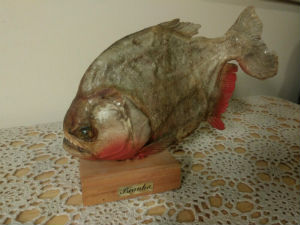
Are Piranhas Venomous to Humans? Debunking the Myth
 Piranhas, often portrayed as aquatic assassins with a taste for human flesh, have long been the subject of myth and misinformation. Their razor-sharp teeth and aggressive behavior have contributed to a pervasive belief that these freshwater fish are not only formidable carnivores but also possess venom capable of causing harm to humans. In this exploration, we aim to unravel the truth behind the piranha myth, separating fact from fiction. By examining their anatomy, behavior, and the science behind their notorious image, we will uncover the reality of whether piranhas are truly venomous to humans or if this is yet another chapter in the sensationalized saga of the animal kingdom.
Piranhas, often portrayed as aquatic assassins with a taste for human flesh, have long been the subject of myth and misinformation. Their razor-sharp teeth and aggressive behavior have contributed to a pervasive belief that these freshwater fish are not only formidable carnivores but also possess venom capable of causing harm to humans. In this exploration, we aim to unravel the truth behind the piranha myth, separating fact from fiction. By examining their anatomy, behavior, and the science behind their notorious image, we will uncover the reality of whether piranhas are truly venomous to humans or if this is yet another chapter in the sensationalized saga of the animal kingdom.The Ferocious Reputation of Piranhas
Piranhas, the infamous denizens of South American waters, have long been portrayed as fearsome predators with razor-sharp teeth capable of stripping flesh from bone within seconds. This depiction has fueled the belief that piranhas are not only voracious carnivores but also possess venomous capabilities, making them a serious threat to humans. Let's delve into the reality behind the sensationalized image of these aquatic creatures.
Anatomy and Behavior of Piranhas
Piranhas are freshwater fish found in rivers and lakes across South America. While they do have sharp teeth designed for tearing into prey, their reputation as indiscriminate killers is largely exaggerated. Piranhas are omnivores, and their diet consists of fish, insects, and even plants. They are known to exhibit aggressive behavior, particularly during the dry season when food is scarce, but their primary motive is survival rather than mindless aggression towards humans.
Teeth vs. Venom: Debunking the Venomous Myth
The misconception that piranhas are venomous likely stems from their powerful jaws and sharp teeth. Contrary to popular belief, piranhas do not possess venom glands. Instead, they rely on their collective strength in numbers and sharp teeth to overwhelm and dismantle prey. While a group of hungry piranhas can inflict serious harm, their bite is not venomous in the way some snakes or spiders deliver venom through specialized glands.
Human-Piranha Interactions
Instances of piranhas attacking humans are rare and usually occur under specific conditions. Attacks are more likely when water levels are low, reducing the availability of their natural prey. Furthermore, human activities such as splashing, which mimics struggling prey, can attract piranhas. However, cases of fatal piranha attacks on humans are extremely rare, and the majority of encounters result in minor injuries that occur when individuals disturb or threaten the fish.
Conservation and Coexistence
Piranhas play a crucial role in maintaining the ecological balance of their habitats. They control the population of smaller fish, helping to preserve the overall health of aquatic ecosystems. Despite their fearsome reputation, piranhas are valuable components of their ecosystems, and efforts should be made to understand and conserve these fascinating creatures. Education about responsible behavior in piranha habitats can contribute to peaceful coexistence between humans and these misunderstood fish.
Conclusion: Separating Fact from Fiction
In conclusion, the idea that piranhas are venomous to humans is a myth perpetuated by sensationalized portrayals in popular culture. While piranhas are indeed formidable predators with sharp teeth and a carnivorous diet, they are not inherently dangerous to humans. Understanding their behavior, ecology, and the circumstances under which interactions may occur is crucial for dispelling the exaggerated fears associated with these fascinating fish.
In the realm of aquatic life, piranhas serve as a reminder that perception often differs from reality. By demystifying the myths surrounding piranhas, we can foster a greater appreciation for the diversity and importance of the natural world.